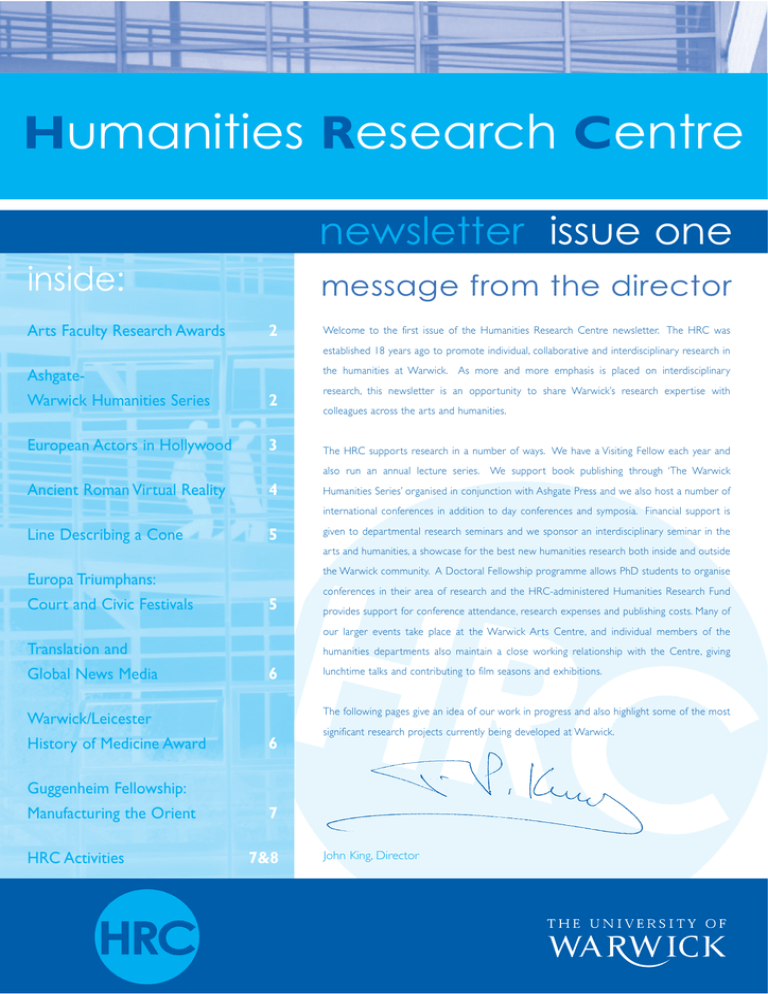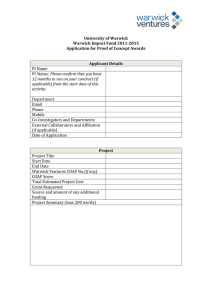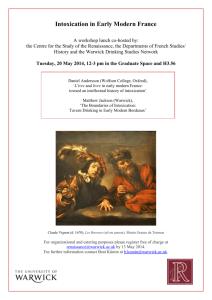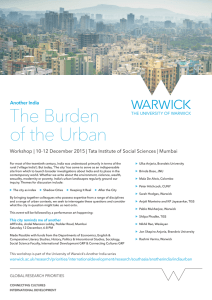H R C umanities
advertisement

Humanities Research Centre newsletter issue one inside: Arts Faculty Research Awards message from the director 2 Welcome to the first issue of the Humanities Research Centre newsletter. The HRC was established 18 years ago to promote individual, collaborative and interdisciplinary research in the humanities at Warwick. As more and more emphasis is placed on interdisciplinary AshgateWarwick Humanities Series 2 European Actors in Hollywood 3 research, this newsletter is an opportunity to share Warwick’s research expertise with colleagues across the arts and humanities. The HRC supports research in a number of ways. We have a Visiting Fellow each year and also run an annual lecture series. We support book publishing through ‘The Warwick Ancient Roman Virtual Reality 4 Humanities Series’ organised in conjunction with Ashgate Press and we also host a number of international conferences in addition to day conferences and symposia. Financial support is Line Describing a Cone 5 given to departmental research seminars and we sponsor an interdisciplinary seminar in the arts and humanities, a showcase for the best new humanities research both inside and outside Europa Triumphans: Court and Civic Festivals the Warwick community. A Doctoral Fellowship programme allows PhD students to organise conferences in their area of research and the HRC-administered Humanities Research Fund 5 provides support for conference attendance, research expenses and publishing costs. Many of our larger events take place at the Warwick Arts Centre, and individual members of the Translation and Global News Media humanities departments also maintain a close working relationship with the Centre, giving 6 The following pages give an idea of our work in progress and also highlight some of the most Warwick/Leicester History of Medicine Award 6 Guggenheim Fellowship: Manufacturing the Orient 7 HRC Activities lunchtime talks and contributing to film seasons and exhibitions. 7&8 significant research projects currently being developed at Warwick. John King, Director The Arts Faculty won a total of £1.5M in research grants and contracts in 2002/03. Arts Faculty Research Awards Major research awards included: Ashgate Warwick Humanities Series Chris Johnston & Adrian Heathfield, Theatre Studies, AHRB Fellowship in the Creative and Performing Arts, £131,000 Andrew Laird, Classics, University of Wisconsin Solmsen Fellowship, £24,000 Anthony Eastmond, History of Art, British Academy Visiting Professorship, £3,000 Hilary Marland, Colin Jones & Mathew Thomson (with Leicester University), History, Wellcome Trust Strategic Award, £592,000 Maxine Berg, History, Guggenheim Fellowship, £23,000 The Warwick Humanities Series, Susan Bassnett, Centre for Translation and Comparative Cultural Studies, AHRB Research Grant, £313,000 published by the HRC in collabora- Elizabeth Clarke, English and Comparative Literary Studies, AHRB Resource Enhancement, £90,500 together innovative work of a high David Dabydeen, Centre for Translation and Comparative Cultural Studies, British Academy Small Grant, £4,500 disciplinary borders in the arts and Liese Perrin Research Support Services volumes exploring new dimensions tion with Ashgate, aims to bring academic standard which crosses of cultural history from the early contact us If you have any comments on this publication or want for works that investigate aspects any further information on the activities of the HRC, of contemporary cultural produc- please contact Sue Dibben: tion within and across national Address: boundaries. The series reflects the Humanities Research Centre, University of Warwick, breadth of the interdisciplinar y Coventry, CV4 7AL Tel: (0)24 7652 3401 Fax: (0)24 7657 2997 E-mail: HRC@warwick.ac.uk Website: www.warwick.ac.uk/fac/arts/hrc work carried out at Warwick's HRC, and includes work of both European and extra-European scope. The series is edited by Dr. Loredana Polezzi (Italian Studies), Dr. Karen O'Brien (English & Comparative Literature) and Dr Sam Haigh (French). 2 Acts of War Tony Howard and John Stokes David Jones, Artist and Poet Edited by Paul Hills humanities. It provides a forum for modern period to the present and The HRC is located in Room 452 of the Humanities Building Titles in the Series: George Eliot and Europe Edited by John Rignall Epistolary Selves Edited by Rebecca Earle The World of Savonarola Edited by Christine Shaw and Stella Fletcher In a Queer Place Edited by Kate Chedgzoy, Emma Francis and Murray Pratt German Culture and the Undesirable Past: Representations of National Socialism in Contemporary Germanic Literature Edited by Helmut Schmitz From left to right: Charles Boyer, French émigré and war activist in Hollywood; Marlene Dietrich and Greta Garbo: European stars as ‘foreign’ women in 1930s Hollywood. European Actors in Hollywood In 1999 I was asked to join a research network on ‘Europeans in Hollywood’ initiated and part-funded by the Maison des Sciences de L’Homme (MSH), Paris. Alongside a major series of meetings, conferences and exhibitions in Paris, Los Angeles and Berlin, smaller research projects have been nurtured, many of which are now approaching completion. My own contribution, which expanded from my previous research on French Journeys of Desire, like the work of the whole network, examines the phenom- stars, was to initiate a project on European actors in Hollywood. This has led to enon of film personnel emigration from the perspectives of the film industry, papers at the network’s meetings in Paris, to a conference in Paris in June 2002, social history and culture, while also studying representations on screen, in the (partly supported by the British Academy), and a book, Journeys of Desire, forms of national types and stereotypes. In the latter category, figures such as European Actors in Hollywood, co-edited with Alastair Phillips (Warwick Film & the Hispanic ‘Latin Lover’, the mysterious ‘foreign women’ embodied by Garbo Television Studies PhD, Lecturer at Reading), which will be published by the BFI and Dietrich and the recent spate of British villains are examined. in 2004. A film retrospective is being planned at the National Film Theatre in London to coincide with the book’s publication. Overarching issues include the tension between Europeans’ desire for Hollywood (hence the title of the book) and the Hollywood film industry’s ruth- Journeys of Desire is a microcosm of the wider research project.The book con- less practice of attracting European talent to serve its own ends, and the ques- tains studies of particular stars (from Maurice Chevalier and Charles Boyer to tion of why some triumphed while others failed, beyond questions of individual Daniel Day-Lewis and Antonio Banderas) and national groups of actors, such as talent. This research – which includes contributions from seven Warwick staff former Tsarist generals playing extras in silent Hollywood movies, and the ‘star members - has revealed fascinating case studies as well as fundamental changes trading’ between the British and American film industries in the 1930s, as well as an exhaustive (we hope) dictionary of all European actors in Hollywood. in an increasingly trans-national film industry, in the practice of emigration and indeed in the very notion of national identity. Ginette Vincendeau Film and Television Studies Humanities Research Centre newsletter The remains of Pompeii's ancient houses and villas show that the Romans decorated their rooms with extravagant wall paintings depicting complex and sumptuous architecture that used tricks of perspective to impress and entertain guests with what almost seems to be an early version of virtual reality. Ancient Roman Virtual Reality Theatre was an integral part of Roman culture and the wall paintings provide an insight into theatre, politics and culture during the transition from Republic to Empire. Now, researchers at the University of Warwick are transforming these ancient forms of perspective painting into the 21st-century version of virtual reality using 3-D digital models that allow viewers to visualise long-lost Roman theatres. The ancient wall paintings depict 3-D architectural structures, including stage sets, on 2-D surfaces. The technique of perspective scenic painting, or skenographia, first evolved in 5th-century BC Greek theatre and was used to embellish the flat façades of stage buildings. Later, the Romans adapted the technique to decorate their homes. The project, funded by the Leverhulme Trust, carried out by the University of Warwick's 3-D Visualisation Group, and directed by Professor Richard Beacham and Dr Hugh Denard from Warwick’s School of Theatre Studies, uses state-of-the-art computer modelling to greatly enhance scholarly understanding of the paintings and the ancient 3D Reconstruction- House of Pinarius Ceralis, Pompeii stages that they depict, and to enable new types of interrogation of Roman visual culture and spectatorship to be pursued. Using wall paintings, photographs, ancient texts, depictions of deteriorated or lost frescos and interpretations of Roman stage formats, the team The team have created the world's first computer generated 3-D mod- creates plausible reconstructions of the structure and scenery of actual els of early temporary wooden sets based upon the evidence from stage buildings. Researchers can then explore 3-D theatre models and ancient paintings. The reconstructions enable researchers to understand gain insights impossible to obtain from a photograph, diagram or draw- these long-vanished structures as places for performance. Often the ing. Virtual 'theatre museums' can open up new possibilities, offering challenge is to discern the real stage image within the sometimes impos- researchers and the wider public fresh perspectives upon the material sible and fantastic painted architecture embellishing it. By analysing the culture of the past. paintings with the aid of computer modelling it is possible to extract the real architecture and discover what the actual theatres may have looked like. 4 Richard Beacham and Hugh Denard School of Theatre Studies Line Describing a Cone Albrecht Durer, The Great Triumphal Car, woodcut (c.1518) [London, British Museum] In January 1973, somewhere mid-Atlantic, the New York based filmmaker Anthony McCall conceived his first ‘solid light’ film, Line Describing a Cone. Shown for the first time in Stockholm later that year McCall’s film is an extraordinarily sensual meditation upon the medium of film and the politics of the audience’s physical and conceptual relationship with it. Some thirty years later this work will be shown again as a part of a major exhibition at the Mead Gallery reflecting on the contemporary relevance of McCall’s astonishingly individual film works. Line… is a performative film which, despite its physical impact and formal elegance, was designed less as an image to be contemplated than as a space for shared experience and interaction. The behaviour of the film’s audience is always fascinating. While viewing the work the audience begin to break the beam, crawl beneath it, curl their bodies around the cone and move along its length, demonstrating their discoveries to each other and activating a traditionally passive space. The exhibition will also include a special one day presentation of Long Film for Four Projectors, 1974, never before shown in Britain. Long Film is McCall’s most Europa Triumphans: Court and Civic Festivals ambitious project and involves four projectors, each positioned in the corner of a rectangular room, each showing four forty minute reels of film. The reels move Extravagantly spectacular, politically strategic, the festivals of con- through the projectors forwards, backwards, back to front and the right way tinental Europe were of great courtly and civic significance dur- round, resulting in an architectural environment with a duration of six hours. ing the Renaissance. The Europa Triumphans research project Wherever the viewer stands within the space they are inside the film, surround- was established in 1995 to further the study of early modern ed by sweeping planes of light that intersect with each other. festivals. Europa Triumphans, directed by Professor Ronnie Mulryne (Warwick) and Professor Helen Watanabe-O’Kelly This will be the first solo show in Britain for McCall and will be accompanied by a comprehensive catalogue and a series of events and talks, including screenings of new work. The exhibition will take place in the Mead Gallery, Warwick Arts (Exeter College, Oxford), is one of three projects under the auspices of the AHRB Centre for the Study of Renaissance Elites and Court Cultures at Warwick. Centre from 12 January-12 March 2004. Helen Legg Mead Gallery, Warwick Arts Centre Under the general editorship of Professors Mulryne and Watanabe-O’Kelly and Dr. Margaret Shewring (Warwick), scholars from Europe and the U.S.A. have worked on texts spanning two centuries and written in numerous languages to produce Europa Triumphans: Court and Civic Festivals in Early Modern Europe, a two-volume collection of festival texts. Produced in the original language and in English translation, this panoramic and richly detailed collection of festival works is divided into eight sections that focus on particular nations, cities and individuals. The volumes will be published by Ashgate in 2004. See: www.warwick.ac.uk/fac/arts/ren/ for further details. Line Describing A Cone installation at the Whitney "Into The Light" exhibition Sarah Knight AHRB Centre for the Study of Renaissance Elites and Court Cultures Humanities Research Centre newsletter Translation and Global News Media Entitled "The cultural politics and economics of language and translation in global media", the project will involve media and translation scholars and professionals in an inter-disciplinary investigation of the significance of translation as a force for media globalisation and regionalisation. The funding will pay for two researchers and a programme of international research seminars and workshops. The focus of this research project is the geopolitical significance of language and translation in international communication. Media research in the past decade has shown enor- The AHRB (Arts and Humanities Research Board) has awarded the Centre for Translation and Comparative Cultural Studies £313,000 for a three-year research project on translation and global news media beginning in September 2003. mous interest in media globalisation, but remarkably, theorists have largely ignored questions of translation arising from linguistic and cultural diversity in regional and national media markets. The project will seek to understand the extent to which translation contributes to processes of globalisation and enriches current approaches to theorising media globalisation. Professor Susan Bassnett will lead the research team. She has a firmly established record for research in translation and has pioneered the 'cultural turn' in Translation Studies that has altered the focus of the discipline towards consideration of broader socio-cultural questions. Joy Sisley, one of the two researchers funded by the grant, has considerable academic and professional experience in the fields of media and communication and Translation Studies. The project represents an important innovation in the field of translation research. It will enhance the Centre's international reputation for interdisciplinary research. Joy Sisley Centre for Translation and Comparative Cultural Studies Warwick/Leicester History of Medicine Award The Centre for the History of Medicine, based in the History Department at the University of Warwick, has won a £600,000 Wellcome Trust Strategic Award for a five-year programme on the ‘Cultures and Practices of Health’, to begin in October 2003. One major research programme associated with the award will highlight ‘The Health of Workers in the Twentieth Century’, drawing on the resources of Warwick’s Modern Records Centre. Another project will focus on ‘The Practice of Medicine in Early Modern Europe’, exploring Further details will be posted shortly on www.warwick.ac.uk/fac/arts/History/medicine Hilary Marland, Centre for the History of Medicine Department of History the relationship between core medical personnel and illicit or informal medical practices. Other research initiatives will examine the history of physiognomy, psychiatry, spa treatment, and medicine and multi-culturalism. Public activities planned for the next five years include an annual seminar series, a web-based occasional papers series, a programme of events with the Leamington Spa Pump Rooms and Gallery and collaboration with the Warwick Writing Programme. Core staff involved in the project are Dr Hilary Marland (Director), Professor Colin Jones, Dr David Hardiman, Dr Sarah Hodges, Dr Claudia Stein and Dr Mathew Thomson at Warwick, together with joint-applicant Dr David Gentilcore of the University of Leicester. The link with Leicester complements the activities of the Leicester-Warwick Medical Schools. 6 The Quack, Jan steen (1626 - 1679) Guggenheim Fellowship: Manufacturing the Orient Professor Maxine Berg of the History Department, who ran the Warwick Luxury Project from 1998-2000, has been awarded a Guggenheim Fellowship for 2003/2004 to embark on a new research project on the connections between luxury and consumer goods in Europe and Asia in the 17th and 18th centuries. s e i t i v acti Humanities Research Centre Interdisciplinary Seminars factured luxury goods from Asia provoked a programme of product Narratives of Testimony: (Post)Colonial Law and Literature innovation in Europe in attempts to ‘imitate’ goods made in the advanced The recent visit to Warwick by the Kenyan intellectual Ngugi wa Thiong’o societies of China and India. (the 2003 Humanities Research Centre Visiting Fellow) served as a cata- Recent global history has focused on reasons for the divergence in eco- lyst for this interdisciplinary seminar series. The seminars will be held in nomic development between Europe and Asia. Manufacturing the Orient 2004 under the joint sponsorship of the HRC and the Law Department. looks instead at connections—that is, at the input of Asian commerce Bringing together experts in fields ranging from migrant writing to colo- into Europe’s consumption and industrial development. The European nial law, from African Studies to Caribbean literature, the series will focus response to Eastern luxury depended heavily upon the Empire, which on the intersections among textual representations of law; individual, gave the British access to substitutes for Asia’s exotic raw materials legal and collective memory; and narratives of human rights. The inten- through American and Caribbean colonies and African trading outlets. tion is to connect the colonial moment with its post-colonial aftermaths These global connections made possible the new desires and consumer across a wide chronological, geographical and linguistic span. cultures which subsequently fostered industrialization. In the ensuing For further information contact: period of product innovation, quality earthenware and cream ware dis- Dr Ambreena Manji (a.manji@warwick.ac.uk) placed Chinese porcelain; British alloys and refined iron and steel were or Dr Loredana Polezzi (l.polezzi@warwick.ac.uk) Manufacturing the Orient pursues the idea that a global trade in manu- applied to ornament in the place of precious stones and gold, and - most significantly of all - copper plate and cylinder-printed calicoes made from machine-spun yarn and machine-woven piece goods displaced hand- The History and Representation of the Emotions painted and dyed, and handspun and woven Indian chintzes. Asian luxu- The past few years have seen burgeoning scholarly interest in human ry goods were thus transformed into new consumer goods. (and animal) emotions. This seminar, held in terms 1 and 2, will draw The Manufacturing the Orient project will include travel to India and upon recent work in literature, history, philosophy, psychology and visual China for research on the fine chintzes and muslins of Ahmedabad and culture to explore the interdisciplinary potential of these lines of inquiry. Pondicherry in India, and the porcelain of Jingdezhen in China. Europeans At the first two sessions, participants will discuss a common set of read- were fascinated by these products and retold fables of their mysterious ings; at the remaining sessions, speakers will read unpublished papers. production processes in treatises, encyclopedias and travel accounts The series will be complemented by a one-day conference (held in throughout the later 17th and 18th centuries. The project will explore 2004) ‘Around the Mouth’, organised by Colin Jones and the Centre for the idea that contemporary perception of craft, skill, quality and the rel- the History of Medicine. ative scale of production and trade in consumer goods were crucial to For further information contact Margot Finn (m.c.finn@warwick.ac.uk) this important phase of connection prior to 19th century domination. Maxine Berg Department of History continued page 8 Humanities Research Centre newsletter Conferences 2003/04 The Humanities Research Centre sponsors many workshops, symposiums and conferences. These range from half-day events to 3-day ies activit continue international residential conferences. Details about conferences can be d obtained from the HRC or from the conference organisers. Information on HRC events is available on our website at: www.warwick.ac.uk/fac/arts/hrc. HRC Visiting Fellow The HRC hosts a distinguished scholar in residence for a week each Forthcoming events include: year. Past Visiting Fellows have included: Ruby Rich (2000), Eugenio Barba (2001), Mario Vargas Llosa (2002) and Ngugi wa Thiong'o Hermeneutics and Traditions (2003). Friday 7th November 2003 Organised by the Centre for Research in Philosophy and Literature Humanities Research Centre Doctoral Fellowships Public Art Public Authorship: Jochen Gerz in Coventry Saturday 29th November 2003 Each year the HRC awards a number of Doctoral Fellowships, which are Organised by Dr Jonathan Vickery (History of Art) in association with designed to enhance work on the recipients’ PhDs. The Fellowships the Mead Gallery, Warwick Arts Centre include a contribution towards students’ research expenses as well as For further information contact: j.p.vickery@warwick.ac.uk funding for a conference on a topic related to their dissertations. Charlotte Ross of the Italian Department held a Doctoral Fellowship in 2002-2003, and organised a conference entitled ‘Literature-Science: Between the Disciplines’ (28 February-1 March 2003). Continental Philosophy and the Sciences 8th - 10th December 2003 Organised by Miguel de Beistegui, Damien Veal and Jon Rubin The above mentioned conference was designed to explore the episte- (Philosophy) mological considerations raised by Science and Literature Studies (SLS). For further information contact the Department of Philosophy Dame Professor Gillian Beer, Dr Daniel Cordle, Professor Ruth Chadwick, Dr Amanda Rees, Dr Felicity Mellor, Dr Jeff Wallace and other scholars drawn from Literary Studies, Bioethics, Sociology and Science Communication spoke at the conference about creative, critically informed ways of crossing the ‘two cultures’ divide. Several hoped for Cross-national Cultural Policy Research: the methodological challenge Saturday 21st February 2004 Organised by Eleonora Belfiore (Cultural Policy) – and some unexpected - connections arose as participants explored the often contrasting methodologies and motivations that shape and inform knowledge production. Perceptions of the Supernatural in the Long Eighteenth Century As an adjunct to the conference, there was an evening of readings by the Saturday 8th May 2004 novelist and scholar Dr Lisa Appignanesi and the poet Professor Robert Organised by Sasha Handley (History) Crawford, whose work highlights the slippery spaces between science and art. The presence of creative writers (who also straddled the writer/critic divide) added a vital edge to the debate on SLS. Annual Donald Charlton Lecture Professor Efrain Kristal (UCLA) Charlotte Ross Department of Italian 8 'Translation and Borges' Thursday 27th November 2003 at 5.30 pm Humanities Research Centre newsletter





